Energy Pyramids Lesson Plan - A Complete Science Lesson Using the 5E Method of Instruction
At the end of this comprehensive lesson about energy pyramids, students will be able to diagram the flow of energy through living systems through the use of an energy pyramid. Each of our lessons is designed using the 5E method of instruction to ensure maximum comprehension by the students. This well-thought out unit does the heavy lifting, giving teachers easy-to-implement, highly engaging lesson plans.
This blog will walk you through each of the steps and activities from the Energy Pyramid 5E Lesson Plan.
ENGAGEMENT
Objective Introduction
At the beginning of the lesson, the class will do a Think-Pair-Share to discuss the objective.
Class Activity
The teacher will ask students what they can recall about food chains and food webs and to describe what happens in a food web. The teacher will write producer and consumer on the board and students will have to compare the two words.
Student Activity
Students will get into groups of four and number themselves one through four. Student one will receive 2000ml of a drink. Student one will then have to give 10% of their drink to student two. Student two will then have to give 10% of their drink to student three. Student three will finally have to give 10% of their drink to student four. This activity is to represent the 10% rule and students will get to visualize exactly how much energy is transferred from one trophic level to the other. Students are not allowed to drink until they have your permission.
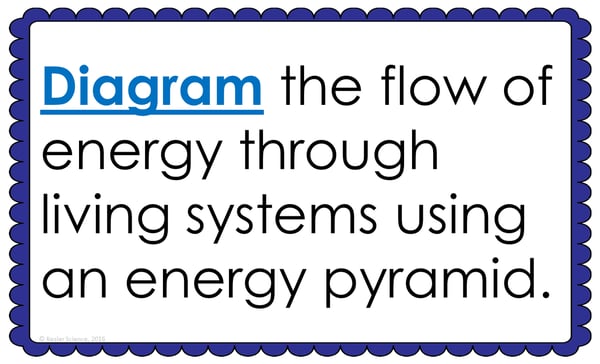
The teacher will then help to clear up any misconceptions their students have about energy pyramids. A common but major misconception, for example, is that students don’t understand that producers use about 90% of the food energy they produce for their own life process, so animals that eat producers only get about 10% of the energy they make. They, in turn, use 90% of the food they eat for themselves and transfer 10% to the animals that eat them.
Estimated Class Time for the Engagement: 20-30 minutes
EXPLORATION
This student-centered station lab is set up so students can begin to explore energy pyramids. With nine stations in total, you can introduce energy pyramids to your middle school students in a variety of ways! Four of these stations are considered input stations where students will learn new information about energy pyramids, and four of the stations are output stations where students will be demonstrating their mastery of the lesson's material. A bonus station offers challenges for your early finishers and independent learners. You can read more about how I set up the station labs here.
Watch It!
At this station, students will be watching a six minute video describing food webs, and energy pyramids. Students will then answer some questions relating to the video and record their answers on their lab station sheet. For example, alternate names for producers and consumers, which levels of the pyramid have the most or least amount of energy, and the role of decomposers in ecosystems.
Read It!
This station will provide students with a one-page reading about energy pyramids. In the reading, students will discover three ways an ecological pyramid can be represented: a pyramid of numbers, pyramid of biomass, and pyramid of energy flow. They will also discover that an ecological pyramid is an illustration of the reduction of energy. There are four follow-up questions that the students will answer to demonstrate their comprehension of the reading material.
Explore It!
Students will be working in pairs to recreate the engagement activity that they went over at the beginning of the energy pyramid lesson. Students will have a beaker and will have to transfer 10% of the “energy” to other containers. This station is to re-establish prior knowledge of the 10% energy transfer rule. Students will then have to answer three questions connecting what they just practiced to how it connects to ecosystems.
Research It!
The research station will allow students to get online and participate with an interactive website about energy pyramids. Students will listen/read information about energy pyramids and what they might look like in a forest, prairie, and ocean ecosystem. With each concept, students will answer a few questions to help make the research more concrete.
Organize It!
The organize it station allows your students to place labels on an energy pyramid. Students will label each level, direction of energy flow, and the amount of Kilo-calories in each level. Students will also identify which level contains herbivores, carnivores, and which levels have the least or most amount of energy.
Illustrate It!
Your visual students will love this station. Students will be creating an energy pyramid representing a desert ecosystem. Students will use color and label each level from producer to tertiary. Students will also have to show the energy flow and label the levels with the most and least amount of energy.
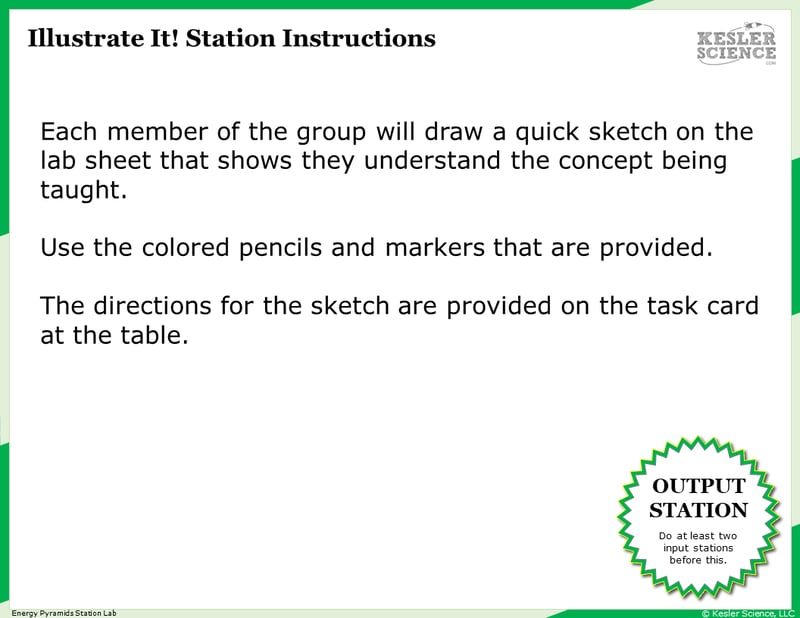
Write It!
Students who can answer open-ended questions about the lab truly understand the concepts that are being taught. At this station, the students will be answering three questions like to describe the transfer of energy as it moves up the energy pyramid, the impact of removing secondary consumers from the ecosystem, and what impact will an out of control population of large predators will have on the ecosystem?
Assess It!
The Assess It station is where students will go to prove mastery over the concepts they learned in the lab. The questions are setup in a standardized format with multiple choice answers. Some questions will ask students: to identify the amount of energy that is transferred from each trophic level, where is most energy stored, best describe energy flows in ecosystems, and where do producers get their energy from?
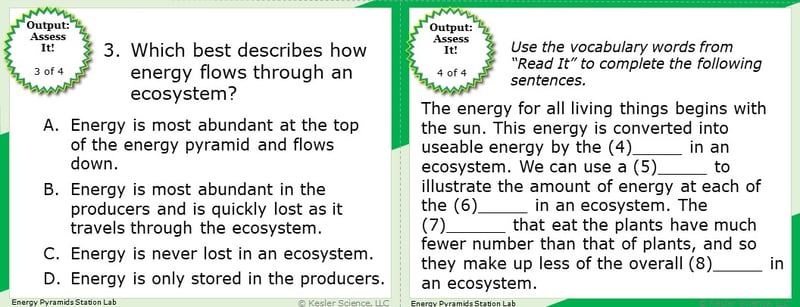
Challenge It! - Bonus Station
Early finishers and advanced students will love the extension activities in this station. Four activity choices offer them ways to expand their learning through mini-games and mini-projects.
Estimated Class Time for the Exploration: One or two 45-minute class periods
EXPLANATION
The explanation activities will become much more engaging for your class once they’ve completed the exploration station lab. During the explanation piece of the lesson, the teacher will be clearing up any misconceptions their students may have about energy pyramids with a variety of materials. These materials include on-level and modified versions of the interactive presentation (may be used individually or projected), anchor charts, and paper or digital interactive notebook activities. If you have students that need modified notes, the 5E lessons come equipped to help give every student access to the lesson.
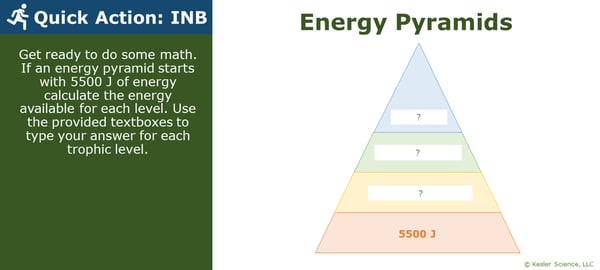
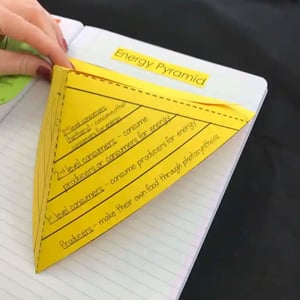
Interactive notebook samples: Above-left is a digital INB activity slide; above-right is an example of the paper INB activities.
The students will also be interacting with their journals using INB templates for energy pyramids. Each INB activity is designed to help students compartmentalize information for a greater understanding of the concept. The energy pyramids INB template will describe the different levels and how much energy is transferred from level to level.
Estimated Class Time for the Exploration: Two or three 45-minute class periods
ELABORATION
The elaboration section of the 5E method of instruction gives students choices that allow them to prove they’ve mastered the concepts behind the lesson. When students are given a choice, they’re much more enthusiastic and invested in the project than they are when their teachers choose their projects for them. There are a total of nine choices to demonstrate understanding of energy pyramids. A separate set of choices that offer more teacher support are also available for students that need them. Rubrics guide students to doing their best work and assist in grading.

Estimated Class Time for the Elaboration: Two or three 45-minute class periods (can also be used as an at-home project)
EVALUATION
The final piece of the 5E model is to evaluate the student's comprehension. Included in every 5E lesson is a homework assignment, assessment, and modified assessment. Research has shown that homework needs to be meaningful and applicable to real-world activities in order to be effective. When possible, I like to give open-ended assessments to truly gauge the student’s comprehension.
Estimated Class Time for the Elaboration: One 45-minute class period
DOWNLOAD THE FULL LESSON NOW
Download Over $100 in FREE Resources
For Middle School Science
Simply create a login below and gain immediate access to a selection of our Kesler Science product line worth $100 - for FREE. There's a full version of every product type! You'll also join tens of thousands of middle school science teachers who receive timely tips and strategies straight to their inbox.







